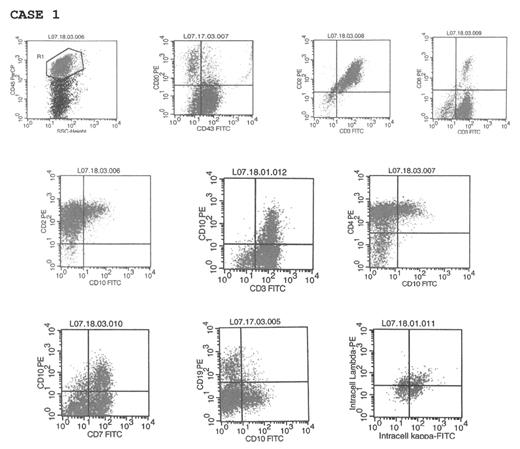Abstract
Background: Angioimmunoblastic T cell lymphoma (AILT) is a peripheral T- cell lymphoma characterized by systemic disease, a polymorphous infiltrate involving lymph nodes with prominent proliferation of high endothelial venules and follicular dendritic cells. We present a novel technique for the presumptive diagnosis of AILT cases by flow cytometric analysis. The diagnosis of AILT was confirmed by histolopathologic features, immunohistochemical stains and molecular studies.
Method: Specimens: Fresh groin excision lymph nodes. Flow cytometric analysis utilizing side scatter versus CD45. Case 1 (figure 1): The gated population consists of 10–12% B cells and 56–61% T cells. CD3, CD4 and CD5 stain 56–61% of the gated cells, while CD7 stains 41% of the gated cells, consistent with aberrant partial loss of CD7 by T cells. A population of abnormal T cells expresses CD10 with CD2, CD3, CD4 and CD7 but not with CD19 (B cells) consistent with aberrant CD10 coexpression by a subset of the T cells (12–19% of the gated cells). Staining for CD34 highlights less than 2% immature cells staining while CD64 stains less than 2% monocytic cells. Surface kappa and lambda staining does not show restriction (kappa: lambda 1–2:1). Cytoplasmic kappa and lambda staining is not interpretable due to non-specific antibody binding. Case 2 (figure 2): The gated population consists of 69% T- cells and 28–33% B- cells. A population of abnormal T cells expresses CD10 with CD2, CD3, CD4 and CD7 but not CD19 consistent with aberrant CD10 expression by a subpopulation of T cells (8–11% of gated cells). Intracellular B cell kappa lambda light chain restriction is not present and there is no aberrant co-expression of CD5, CD10 or CD43 by B cells. The diagnosis of AILT was confirmed by standard morphologic, immunoperoxidase and molecular methods subsequently in both of these cases.
Discussion: Aberrant CD10 expression on neoplastic T cells has been shown with immunohistochemical staining of paraffin embedded tissue in AILT. Our cases show aberrant coexpression of CD10 by CD2, CD3, CD4 and CD7 positive T cells in more than 10% of gated cells by Flow cytometric analysis.
Conclusion: Flow Cytometric analysis is a useful and reproducible tool for immunophenotyping AILT cells and should be considered for presumptive diagnosis of AILT.
Author notes
Corresponding author



